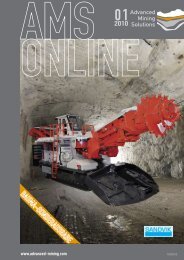A new face drilling rig for narrow tunnels and ... - Advanced Mining
A new face drilling rig for narrow tunnels and ... - Advanced Mining
A new face drilling rig for narrow tunnels and ... - Advanced Mining
Create successful ePaper yourself
Turn your PDF publications into a flip-book with our unique Google optimized e-Paper software.
the classical mechanics through a fictitious total friction<br />
coefficient, the progress resistance coefficient λ h , from<br />
a known reference value, in our case the volume flow I V ,.<br />
Thus the input power is calculated from<br />
P = ρ ⋅ IV<br />
⋅ g ⋅ λh<br />
Issue 04 | 2010<br />
( ⋅ L + H )<br />
The bulk density ρ, the volume I V, the progres<br />
resistance coefficient λ, as well as the geometry<br />
parameters conveying length L <strong>and</strong> conveying height H.<br />
Entscheidender The decisive difference in the <strong>new</strong> method<br />
is the definition of the progress resistance coefficient λ h as<br />
a multidimensional parameter. While the DIN 15262 defines<br />
the progress resistance value as a constant value that is<br />
specific to bulk materials, the <strong>new</strong> method takes stock of<br />
the knowledge gained through experiments , so that the<br />
progress resistance coefficient depends on geometry-,<br />
operational <strong>and</strong> bulk material parameters. The calculation<br />
can be obtained from the papers of Blomeyer [4].<br />
Methods of dimensioning <strong>and</strong> sizing <strong>for</strong> vertically<br />
operated screw conveyors are also mentioned in the<br />
above-mentioned tasks. These methods were realized<br />
as partly graphic methods. Since, as mentioned above,<br />
purely rotational conveying characteristics are<br />
present in a vertical conveyor, the bulk material<br />
in the conveyor is conveyed upwards in a helix.<br />
Thus the velocity of the goods is reduced by a<br />
rotational portion, the angular speed of material<br />
ω . There<strong>for</strong>e the achievable volume flow I is<br />
G V<br />
calculated as.<br />
I<br />
V<br />
= A⋅<br />
v<br />
= ϕ ⋅<br />
ax<br />
(2)<br />
⎛ ω<br />
⋅π<br />
⋅ S ⋅⎜<br />
n −<br />
⎝ 2π<br />
1 2<br />
G<br />
⋅ D 4<br />
⎞<br />
⎟<br />
⎠<br />
(3)<br />
The angular speed of material ω G can be<br />
calculated through an equation of motion.<br />
However, since this should be done separately<br />
<strong>for</strong> each individual case, determination of the<br />
volume flow is offered as a graphic method. A<br />
respective diagram <strong>for</strong> filling levels of φ = 0,4 is<br />
shown in picture 3.<br />
The calculation of the required driving<br />
power is done similar to the procedure in range<br />
I. Again a total friction power is calculated,<br />
which is a product of a conveying factor <strong>and</strong><br />
the analytical determined power based on the<br />
friction against the tube <strong>and</strong> the screw. The<br />
power loss through lifting of the bulk material is<br />
Volume Flow [m³/s]<br />
0,50<br />
0,40<br />
0,30<br />
0,20<br />
0,10<br />
0,00<br />
TRANSFER OF TECHNOLOGY<br />
again added. Analog to the progress resistance coefficient,<br />
the conveying factor is a parameter that is dependant on<br />
geometry- operational <strong>and</strong> bulk materials parameters.<br />
Accurate calculation <strong>for</strong>mulas, as well as further diagrams<br />
<strong>for</strong> determination of volume flow can be obtained from the<br />
paper of Rong [6].<br />
In previous years the Institute <strong>for</strong> Materials H<strong>and</strong>ling<br />
Material Flow Logistics (fml) has also done examinations<br />
on highly inclined screw conveyors. Building on the<br />
task of Gabler [7], Vollmann [1] developed even more<br />
detailed calculation algorithms <strong>and</strong> programmes, which<br />
allow <strong>for</strong> calculation of volume flow <strong>and</strong> driving power<br />
of highly inclined screw conveyors. These are based on<br />
0,4<br />
0,6<br />
0,8<br />
1,0<br />
1,2<br />
1,4<br />
Pic. 3:<br />
Diagram to determine the volume flow in vertical<br />
screw conveyors [3] <strong>for</strong> a filling level of 0.4<br />
1,6<br />
1,8<br />
2,0<br />
2,2<br />
D = 0,800 m<br />
vax =<br />
2,4 m/s<br />
0,630<br />
0,500<br />
1 3 5 7 9 11 13 15<br />
Rotation Speed [1/s]<br />
0,400<br />
0,315<br />
0,250<br />
0,200<br />
www.advanced-mining.com<br />
45
















